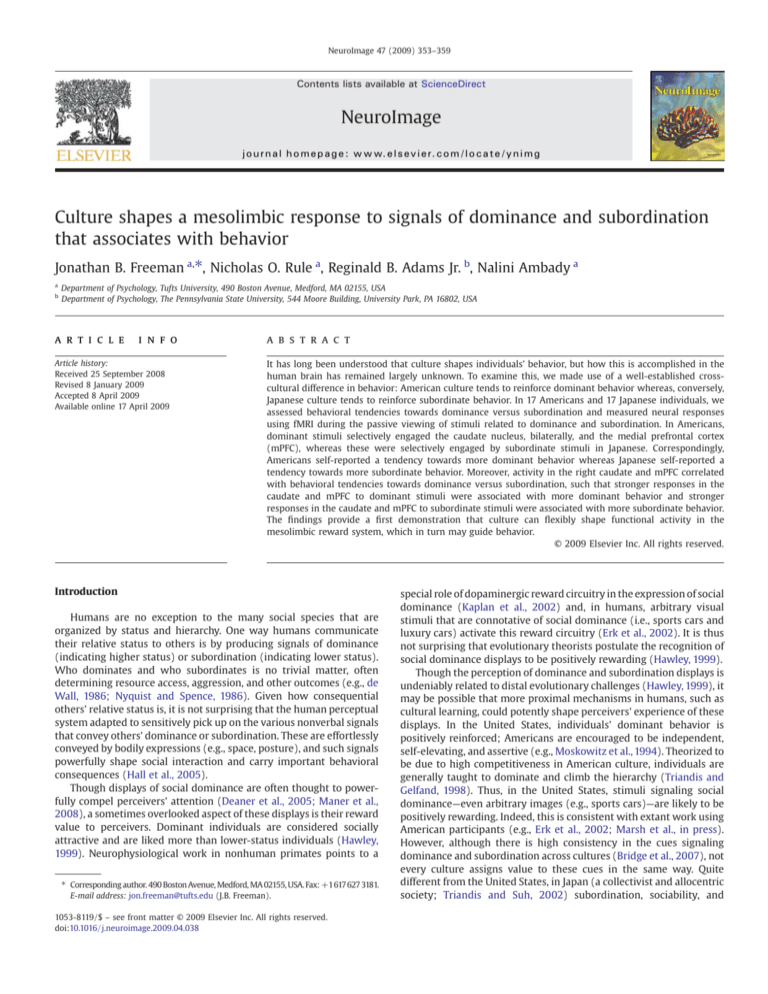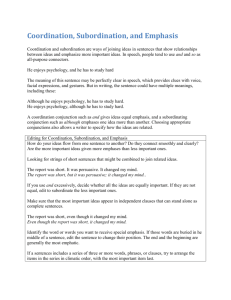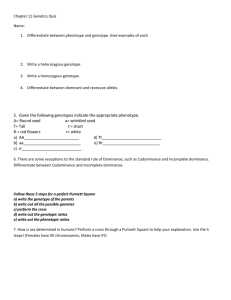
NeuroImage 47 (2009) 353–359
Contents lists available at ScienceDirect
NeuroImage
j o u r n a l h o m e p a g e : w w w. e l s ev i e r. c o m / l o c a t e / y n i m g
Culture shapes a mesolimbic response to signals of dominance and subordination
that associates with behavior
Jonathan B. Freeman a,⁎, Nicholas O. Rule a, Reginald B. Adams Jr. b, Nalini Ambady a
a
b
Department of Psychology, Tufts University, 490 Boston Avenue, Medford, MA 02155, USA
Department of Psychology, The Pennsylvania State University, 544 Moore Building, University Park, PA 16802, USA
a r t i c l e
i n f o
Article history:
Received 25 September 2008
Revised 8 January 2009
Accepted 8 April 2009
Available online 17 April 2009
a b s t r a c t
It has long been understood that culture shapes individuals' behavior, but how this is accomplished in the
human brain has remained largely unknown. To examine this, we made use of a well-established crosscultural difference in behavior: American culture tends to reinforce dominant behavior whereas, conversely,
Japanese culture tends to reinforce subordinate behavior. In 17 Americans and 17 Japanese individuals, we
assessed behavioral tendencies towards dominance versus subordination and measured neural responses
using fMRI during the passive viewing of stimuli related to dominance and subordination. In Americans,
dominant stimuli selectively engaged the caudate nucleus, bilaterally, and the medial prefrontal cortex
(mPFC), whereas these were selectively engaged by subordinate stimuli in Japanese. Correspondingly,
Americans self-reported a tendency towards more dominant behavior whereas Japanese self-reported a
tendency towards more subordinate behavior. Moreover, activity in the right caudate and mPFC correlated
with behavioral tendencies towards dominance versus subordination, such that stronger responses in the
caudate and mPFC to dominant stimuli were associated with more dominant behavior and stronger
responses in the caudate and mPFC to subordinate stimuli were associated with more subordinate behavior.
The findings provide a first demonstration that culture can flexibly shape functional activity in the
mesolimbic reward system, which in turn may guide behavior.
© 2009 Elsevier Inc. All rights reserved.
Introduction
Humans are no exception to the many social species that are
organized by status and hierarchy. One way humans communicate
their relative status to others is by producing signals of dominance
(indicating higher status) or subordination (indicating lower status).
Who dominates and who subordinates is no trivial matter, often
determining resource access, aggression, and other outcomes (e.g., de
Wall, 1986; Nyquist and Spence, 1986). Given how consequential
others' relative status is, it is not surprising that the human perceptual
system adapted to sensitively pick up on the various nonverbal signals
that convey others' dominance or subordination. These are effortlessly
conveyed by bodily expressions (e.g., space, posture), and such signals
powerfully shape social interaction and carry important behavioral
consequences (Hall et al., 2005).
Though displays of social dominance are often thought to powerfully compel perceivers' attention (Deaner et al., 2005; Maner et al.,
2008), a sometimes overlooked aspect of these displays is their reward
value to perceivers. Dominant individuals are considered socially
attractive and are liked more than lower-status individuals (Hawley,
1999). Neurophysiological work in nonhuman primates points to a
⁎ Corresponding author. 490 Boston Avenue, Medford, MA 02155, USA. Fax: +1617627 3181.
E-mail address: jon.freeman@tufts.edu (J.B. Freeman).
1053-8119/$ – see front matter © 2009 Elsevier Inc. All rights reserved.
doi:10.1016/j.neuroimage.2009.04.038
special role of dopaminergic reward circuitry in the expression of social
dominance (Kaplan et al., 2002) and, in humans, arbitrary visual
stimuli that are connotative of social dominance (i.e., sports cars and
luxury cars) activate this reward circuitry (Erk et al., 2002). It is thus
not surprising that evolutionary theorists postulate the recognition of
social dominance displays to be positively rewarding (Hawley, 1999).
Though the perception of dominance and subordination displays is
undeniably related to distal evolutionary challenges (Hawley, 1999), it
may be possible that more proximal mechanisms in humans, such as
cultural learning, could potently shape perceivers' experience of these
displays. In the United States, individuals' dominant behavior is
positively reinforced; Americans are encouraged to be independent,
self-elevating, and assertive (e.g., Moskowitz et al., 1994). Theorized to
be due to high competitiveness in American culture, individuals are
generally taught to dominate and climb the hierarchy (Triandis and
Gelfand, 1998). Thus, in the United States, stimuli signaling social
dominance—even arbitrary images (e.g., sports cars)—are likely to be
positively rewarding. Indeed, this is consistent with extant work using
American participants (e.g., Erk et al., 2002; Marsh et al., in press).
However, although there is high consistency in the cues signaling
dominance and subordination across cultures (Bridge et al., 2007), not
every culture assigns value to these cues in the same way. Quite
different from the United States, in Japan (a collectivist and allocentric
society; Triandis and Suh, 2002) subordination, sociability, and
354
J.B. Freeman et al. / NeuroImage 47 (2009) 353–359
cooperation—not dominance—tend to be positively reinforced (Triandis and Gelfand, 1998). Japanese society typically encourages
individuals to be agreeable rather than dominant (Moskowitz et al.,
1994; Realo et al., 1997) and affiliative rather than competitive
(Yamaguchi et al., 1995). Allocentric cultures, such as Japan's, stress
the importance of appearing to others as responsive to their needs and
concerns (Cross et al., 2000) and to feel a sense of obligation to them
(Oyserman et al., 1998). For instance, in Japanese culture, the
quintessential hero is often characterized as one that possesses
unassailable strength (similar to in American culture) but, more
importantly, is one that maintains a profound humility and readily
displays vulnerability (de Mente, 2006). Because in Japan appearing
subordinate to others tends to be positively reinforced, for Japanese
individuals, stimuli signaling subordination—not dominance—are
likely to be positively rewarding (Nakane, 1970; Rosenberger, 1995).
Given this cross-cultural difference in the valuation of dominance
and subordination, we investigated whether this difference in
culturally learned reward assignments would manifest as different
patterns of functional activity in the neural mechanisms responsible
for processing these. Researchers have long understood that human
culture powerfully shapes individuals' behavior, but only recently
have they begun to examine how culture influences the functioning of
the neural systems underlying it (Chiao and Ambady, 2007; Han and
Northoff, 2008). It is currently unknown whether culture can shape
responses in primary reward mechanisms of the human brain.
Considering that these mechanisms are at the seat of human
motivation, decision-making, and behavior (Schultz, 2000), it is
important to test whether they could be constrained by the highorder influences of human culture. Here we investigate whether
culture can shape responses in primary reward mechanisms of the
human brain, which in turn associate with behavior.
A growing body of neuroimaging research on mesolimbic reward
circuitry has demonstrated that this circuitry not only responds to
primary reinforcers such as food and sex but also to more abstract
cognitive rewards (i.e., “secondary” reinforcers that come to take on
motivational significance through learning; Schultz, 2000), such as
money, attractive faces, and symbols of status (e.g., Aharon et al.,
2001; Breiter et al., 2001). Moreover, recent studies have implicated
this same mesolimbic circuitry in processing the learned reward value
of even complex social stimuli or phenomena (see Knutson and
Wimmer, 2007 for review). For instance, during social interaction, this
circuitry shows increased activity in response to cooperation (Rilling
et al., 2002) and revenge (de Quervain et al., 2004). Moreover, the
caudate nucleus, a key player in the mesolimbic reward system,
exhibits patterns of activity that reflect updates about another's social
reputation and trustworthiness during two-person interactive economic exchange (King-Casas et al., 2005). Although such studies show
that humans are capable of flexibly learning to assign reward value to
novel and complex social stimuli, and that the mesolimbic dopamine
system classically understood as processing unlearned primary
rewards similarly processes these learned secondary social rewards,
it still remains unknown whether reward-related mesolimbic activity
may be shaped by high-level cultural learning. Here we use a
difference in culturally reinforced behaviors (dominance and subordination in Japan and the United States) to examine cultural
influences on reward and related behavior in the human brain.
Event-related functional magnetic resonance imaging (fMRI) was
used to measure blood oxygenation-level-dependent (BOLD) signals
in individuals from Japan and individuals from the United States while
they viewed visual stimuli related to dominance and subordination.
Given that American culture positively reinforces dominance whereas
Japanese culture positively reinforces subordination, we hypothesized
that Americans would show stronger reward-related mesolimbic
activity to dominant stimuli relative to subordinate, whereas Japanese
individuals would show the reverse pattern: stronger reward-related
mesolimbic activity to subordinate stimuli relative to dominant.
Additionally, if these two cultures indeed differentially reinforce
dominance and subordination, we should expect to see a difference
between Americans and Japanese in actual self-reported behavioral
tendencies towards dominance and subordination (i.e., Americans
should be more inclined towards dominant behavior and Japanese
more inclined towards subordinate behavior). Lastly, given that the
mesolimbic dopamine system activates in response to reinforcers
ultimately for motivating and commanding behavior (Arias-Carrión
and Pöppel, 2007; Schultz, 2000), we tested whether mesolimbic
BOLD responses to signals of dominance and subordination could
predict individual differences in behavioral tendencies towards
dominance versus subordination. Taken together, such findings
would reveal that culture can shape the basic neural mechanisms
underlying reward, which in turn relate to human behavior.
Materials and methods
Participants
Seventeen right-handed healthy volunteers born and raised in the
United States (8 male) and 17 right-handed healthy volunteers born and
raised in Japan (8 male) participated in the study. All participants gave
informed consent in a manner approved by the Massachusetts Institute
of Technology's Committee On the Use of Humans as Experimental
Subjects and were paid for their participation. Both Americans and
Japanese were scanned at the Athinoula A. Martinos Center for
Biomedical Imaging in Cambridge, MA. At the time of scanning, Japanese
participants were residing in the United States for approximately one
month in completion of a study abroad program hosted by Tufts
University. All Japanese participants were born in Japan and were
lifetime residents of Japan; all American participants were born in the
United States and were lifetime residents of the United States.
Behavioral procedure
Stimuli included 36 dominant displays, 36 subordinate displays, and
36 random displays of the body unrelated to dominance or subordination (used as fillers to reduce participants' awareness of the research
question). Body displays were photographs of 5 male actors, converted
into figural outlines (so as to preserve only nonverbal information about
dominance/subordination and remove cultural membership cues; e.g.,
Ambady et al., 2000) and placed onto a white background (see Fig. 1),
consistent with previous research (see Hall et al., 2005). Stimuli and
an additional 36 baseline trials (fixation cross) were passively viewed
each for 2 s in one of three pseudorandomized orders, each
sequenced in a manner as to maximize the efficiency of eventrelated BOLD signal estimation (Dale, 1999).
Following the fMRI task, participants completed a questionnaire,
adapted from Goldberg et al.'s (2006) International Personality Item
Pool, which indexed behavioral tendencies of dominance versus
subordination. Participants were asked to indicate how accurately
(1 — “very inaccurate” to 5 — “very accurate”) 15 statements
described their behavior (e.g., “I impose my will on others”; “I let
others make the decisions”). See Table 1 for a list of all statements.
Subordinate statements, such as the latter example, were reverse
coded, and subtracted by a constant of 3 such that negative scores
indicate a tendency towards subordination and positive scores
indicate a tendency towards dominance.
fMRI acquisition
Participants were scanned using a Siemens 3 T Tim Trio scanner at
the Massachusetts Institute of Technology, Martinos Imaging Center.
Anatomical images were acquired using a T1-weighted protocol
(256× 256 matrix, 128 1.33-mm sagittal slices). Functional images
were acquired using a single-shot gradient echo EPI sequence
J.B. Freeman et al. / NeuroImage 47 (2009) 353–359
Fig. 1. Examples of a (A) subordinate display and a (B) dominant display, consistent
with previous research (Ambady et al., 2000; Hall et al., 2005).
(TR = 2000 ms, TE = 30 ms). Thirty-two interleaved oblique-axial slices
(3.125× 3.125× 5 mm voxels; slice gap = 1 mm) parallel to the AC–PC
line were obtained. Analysis of the imaging data was conducted using
BrainVoyagerQX (Brain Innovation, Maastricht, Netherlands). Functional imaging data preprocessing included 3D motion correction, slice
scan time correction (sinc interpolation), spatial smoothing using a 3D
Gaussian filter (7-mm FWHM), and voxelwise linear detrending and
high-pass filtering of frequencies (above 3 cycles per time course).
Structural and functional data of each participant were transformed to
standard Talairach stereotaxic space (Talairach and Tournoux, 1988).
fMRI analysis
Each participant's BOLD signals corresponding with individual
conditions were modeled in an event-related design as boxcar functions
convolved with a two-gamma hemodynamic response function. Firstlevel general linear model (GLM) analyses conducted on individual
participants' fMRI signal were submitted to a second-level random
effects analysis, treating participants as a random factor. For group-level
whole-brain analyses, we controlled for multiple statistical testing of
voxels within the entire brain, maintaining a false positive detection rate
of p b .001 by using a voxelwise threshold of p b .001 and a minimum
cluster size of 189 mm3. The minimum cluster size needed to maintain
the false positive detection rate was empirically determined by a Monte
Carlo simulation, accounting for spatial correlations in BOLD signal
changes of neighboring voxels (Forman et al., 1995). Statistical maps
depicting BOLD responses were overlaid onto an average image of all
participants' corresponding structural data.
Results
Given that American culture and Japanese culture are believed to
differentially reinforce dominance and subordination, respectively, we
355
expected American and Japanese participants to show a corresponding difference in actual behavioral tendencies towards these. As
anticipated, self-reported behavioral tendencies towards dominance
and subordination significantly differed between Americans and
Japanese, t(32) = 2.04, p b .05 (two-tailed test). Specifically, Americans reported a tendency towards more dominant behavior (M = .29,
SE = .14), whereas Japanese reported a tendency towards more
subordinate behavior (M = −.14, SE = .16). Means and standard errors
for each questionnaire item, separately for the two cultures, appear in
Table 1.
Although not directly related to the primary research question, we
initially determined whether any brain regions showed stronger
responses to dominant displays relative to subordinate displays,
regardless of culture, by conducting a dominant N subordinate contrast
using a whole-brain analysis (p b .001, corrected). This analysis revealed
activity in the left inferior parietal lobule (IPL; x, y, z = −48, −37, 46,
520 mm3, t = 4.77) and in the bilateral lingual gyri (right: x, y, z = 17,
−91, 22, 1052 mm3, t = 4.83; left: x, y, z = −12, −93, 15, 2896 mm3,
t = 5.24). When threshold was slightly relaxed (voxelwise p b .005;
minimum cluster size N250 mm3), the right IPL (x, y, z = 42, −36, 51,
1489 mm3, t = 3.88) and a ventral aspect of the medial prefrontal
cortex (mPFC; ventral BA 10; x, y, z = −14, 52, −1, 291 mm3, t = 3.55)
additionally emerged. This pattern of activity is consistent with
previous research on the perception of status cues from the human
face (Karafin et al., 2004; Marsh et al., in press). We used the inverse
contrast (subordinate N dominant) to assess whether any regions
showed stronger responses to subordinate displays relative to
dominant, regardless of culture (p b .001, corrected). This analysis
revealed no regions of activation that survived correction.
To assess the primary hypothesis—that Americans and Japanese
would exhibit opposite patterns of a reward-related response to
precisely the same signals of dominance and subordination—we
conducted a whole-brain mixed-model analysis of variance (ANOVA),
testing a status display (dominant, subordination) × culture (Japanese, American) interaction effect (p b .001, corrected). This revealed
robust activity in the head of the caudate nucleus, bilaterally (right: x,
y, z = 7, 17, 8, 845 mm3, F = 30.99; left: x, y, z = − 11, − 18, 5,
677 mm3, F = 20.54) and in a dorsal aspect of the mPFC (dorsal BA 10;
x, y, z = 8, 59, 23, 196 mm3, F = 17.14). To specify the nature of this
interaction, parameter estimates (beta values) for each of the
conditions (dominant and subordinate) were extracted from all
Table 1
Questionnaire items indexing behavioral tendencies towards dominance versus
subordination, adapted from Goldberg et al.'s (2006) International Personality Item
Pool.
Statement
Japanese
Americans
M
SE
M
SE
Dominant
I try to surpass others' accomplishments.
I want to control the conversation.
I am not afraid of providing criticism.
I challenge others' points of view.
I lay down the law to others.
I put people under pressure.
I impose my will on others.
I express myself easily.
I try to lead others.
I am the first to act.
I take control of things.
3.82
2.41
2.76
3.00
2.12
1.76
2.29
3.18
2.94
3.12
2.71
0.26
0.29
0.33
0.32
0.21
0.22
0.29
0.27
0.33
0.35
0.25
3.88
2.47
3.29
3.65
2.18
2.24
2.18
3.65
3.59
3.53
3.29
0.22
0.23
0.33
0.21
0.26
0.22
0.25
0.30
0.24
0.26
0.27
Subordinate
I wait for others to lead the way.
I let others make the decisions.
I am not highly motivated to succeed.
I can't come up with new ideas.
3.00
2.94
2.29
3.00
0.28
0.20
0.36
0.30
2.53
2.82
1.53
1.65
0.31
0.26
0.26
0.23
Means and standard errors are presented as original scores: 1 = “very inaccurate” and
5 = “very accurate.”
356
J.B. Freeman et al. / NeuroImage 47 (2009) 353–359
voxels within each of these regions (Fig. 2). In Americans, these
regions showed significantly stronger BOLD responses to dominant
displays relative to subordinate displays: left caudate [t(16) = 3.93,
p = .001 (two-tailed)], right caudate [t(16) = 3.51, p b .01 (twotailed)], mPFC [t(16) = 2.53, p b .05 (two-tailed)]. However, in Japanese, these same regions showed the reverse pattern, exhibiting
significantly stronger BOLD responses to subordinate displays relative
to dominant displays: left caudate [t(16) = 3.50, p b .01 (two-tailed)],
right caudate [t(16)=5.12, p=.0001 (two-tailed)], mPFC [t(16)=3.57,
pb .01 (two-tailed)]. Thus, Americans exhibited stronger mesolimbic
reward-related activity to dominant displays, whereas Japanese—in
response to the very same stimuli—exhibited stronger mesolimbic
activity to subordinate displays.
Finally, to determine whether these mesolimbic responses to
dominant and subordinate displays were related to participants'
actual tendencies towards dominant or subordinate behavior, we first
calculated BOLD signal difference scores [dominant – subordinate] by
subtracting beta values for the subordinate condition from beta values
for the dominant condition, separately for each participant. Thus,
positive scores indicate stronger responses to dominant displays
whereas negative scores indicate stronger responses to subordinate
displays. We then examined the relationship between these difference
scores and participants' reported behavioral tendencies towards
dominance/subordination. Indeed, [dominant – subordinate] BOLD
signal difference scores significantly correlated with participants' selfreported behavioral tendencies towards dominance or subordination:
right caudate [r(32) = .34, p b .05 (two-tailed)], mPFC [r(32) = .44,
p b .01 (two-tailed)], and a similar positive trend in the left caudate
that did not reach significance [r(32) = .16, p = n.s. (two-tailed)]
(Fig. 3). Thus, the stronger the BOLD responses in the caudate and
mPFC were to dominant stimuli, the more dominant participants
reported their behavior to be; the stronger the BOLD responses in
the caudate and mPFC were to subordinate stimuli, the more
subordinate participants reported their behavior to be.
Discussion
Here we found that when American and Japanese participants
perceived identical signals of dominance and subordination, in
Americans, the caudate and mPFC showed selective responses to
dominant stimuli, whereas, conversely, in Japanese, these same
regions showed selective responses to subordinate stimuli. Complementing this, Americans reported a tendency towards more dominant
behavior whereas Japanese individuals reported a tendency towards
more subordinate behavior. Moreover, BOLD signals in the caudate
and mPFC correlated with reported dominant/subordinate behavioral
tendencies, such that participants exhibiting greater activation for
dominant stimuli exhibited a greater tendency towards more
dominant behavior whereas participants exhibiting greater activation
for subordinate stimuli exhibited a greater tendency towards more
subordinate behavior. Taken together, these results provide a first
demonstration that human culture can compel patterns of functional
activity in mesolimbic reward circuitry, which in turn associates with
behavior.
The head of the caudate nucleus has long been implicated in
reward-related processing across species, specifically in reward
detection and the associative learning of rewards (Balleine et al.,
2007; Graybiel, 2005; Williams and Eskandar, 2006). It is sensitive to a
variety of motivationally significant stimuli, both positively rewarding
and negatively aversive (Graybiel, 2005), and, consistent with the
Fig. 2. Whole-brain analysis testing a status display × culture interaction effect (p b .001, corrected), revealing responses in the right caudate, left caudate, and mPFC. In Americans,
these regions showed reliably stronger BOLD responses to dominant stimuli relative to subordinate stimuli; in Japanese, these same regions exhibited the opposite pattern, showing
reliably stronger BOLD responses to subordinate stimuli relative to dominant stimuli.
J.B. Freeman et al. / NeuroImage 47 (2009) 353–359
Fig. 3. Correlations between participants' self-reported behavioral tendencies towards
dominance/subordination and BOLD responses revealed by the whole-brain analysis
testing a status display × culture interaction effect. There was a statistically significant
correlation between behavioral tendencies of dominance/subordination and [dominant –
subordinate] BOLD signal difference scores from the (A) right caudate and (B) mPFC. BOLD
signal difference scores were calculated by subtracting beta values for the subordinate
condition from beta values for the dominant condition, separately for each participant.
Thus, the stronger the responses were in the right caudate and mPFC to dominant stimuli,
the more dominant participants reported their behavior to be; the stronger the responses
were in the right caudate and mPFC to subordinate stimuli, the more subordinate
participants reported their behavior to be.
present findings, activity in the caudate nucleus can predict rewardoriented behavior in nonhuman primates (e.g., Itoh et al., 2003).
Recent evidence has set apart the caudate from the larger mesolimbic
reward system for its specific involvement in action-contingency
learning through reward-prediction error coding (Delgado et al.,
2005; O'Doherty et al., 2004; Tricomi et al., 2004). Such evidence
suggests that a primary role of the caudate nucleus is associating
behaviors with their reward consequences. Given that the caudate can
flexibly associate behaviors with their reward value and, as described
357
earlier, can process the learned reward values of complex social
phenomena such as cooperation (Rilling et al., 2002), revenge (de
Quervain et al., 2004), and social reputation and trust during
interactive economic exchange (King-Casas et al., 2005), it is fitting
that here we find that caudate responses can be flexibly shaped by
human culture and correlated with social behavior (behavioral
tendencies of dominance and subordination). Taken together with
prior studies of the caudate's role in learning behavior—reward
associations and processing the learned reward value of complex
social phenomena, the present findings point to the caudate as a
critical player in shaping culturally-specific human behavior by
linking the associations between particular behaviors (e.g., dominance and subordination) and their cultural reward value.
The mPFC (BA 10) has also been consistently implicated in rewardrelated processing across species (Tzschentke, 2000; Wise, 2005) and
carries the densest dopaminergic input in the cortex, making it a key
player in mesolimbic reward circuitry (Tzschentke, 2000). It is
connected to the caudate and encompassing striatum via mesocorticolimbic projections and, like the striatum, the mPFC has also been
shown to respond to learned secondary reinforcers. For instance,
relative to normals, the mPFC in alcoholics shows stronger responses
to alcohol-related visual stimuli in a way that associates with drugseeking behavior (i.e., obtaining alcohol; Grüsser et al., 2004), a
finding somewhat analogous to that reported here. Beyond its role in
monitoring rewards (Thut et al., 1997), several neuroimaging studies
point to the mPFC's involvement in representations of the self (e.g.,
Kelley et al., 2002) and sentiments related to social and moral values
(Moll et al., 2008). These studies suggest that the pattern of mPFC
responses found here may relate not to the detection or monitoring of
the reward per se, but to a retrieval or representation of self-relevant
cultural values (i.e., for Americans, the value of the self as dominant;
for Japanese, the value of the self as subordinate), which in turn may
guide the caudate's reward-related response that is associated with
behavior. Future research could further characterize the particular role
of the mPFC in culture-bound reward and related behavior.
Converging with prior studies using American participants
(Karafin et al., 2004; Marsh et al., in press), here we found that a
ventral aspect of the mPFC was selectively engaged by dominant
stimuli, regardless of culture. Researchers have previously suggested
that the selective involvement of this ventral mPFC region in
responding to cues of dominance is likely related to reward
representation (Marsh et al., in press). This highlights a dissociation
in the mPFC between a more ventral region showing stronger
responses to dominant stimuli relative to subordinate stimuli,
irrespective of culture, and a more dorsal region showing stronger
responses to either dominant stimuli or subordinate stimuli, dependent on whichever is culturally reinforced. The present findings thus
demonstrate that although both the ventral and dorsal mPFC are
involved in a reward-related response to status cues, the ventral
aspect appears to be insensitive to cultural learning (showing a
culture-independent increase in activity for dominant cues) whereas
the dorsal aspect is indeed shaped by cultural learning (showing a
culture-dependent increase in activity for whichever status cue is
positively reinforced).
Some readers may be concerned by the possibility that the
reported caudate and dorsal mPFC responses might reflect merely
an effect of visual attention: that dominant and subordinate displays
captured attention differently in Americans and Japanese. If such were
the case, however, brain areas associated with enhanced visual
attention (namely, striate and extrastriate regions) should have
emerged in the whole-brain analysis testing a status display × culture
interaction effect. Inconsistent with this, we found that characteristic
areas of enhanced visual processing, including the bilateral lingual
gyri (Kastner and Ungerleider, 2000) and the bilateral IPL, an area
involved in representing displays of the human body including their
intention (Decety et al., 1994; Stephan et al., 1995), showed stronger
358
J.B. Freeman et al. / NeuroImage 47 (2009) 353–359
responses to dominant displays relative to subordinate displays,
consistently across both Americans and Japanese. This converges with
evidence demonstrating that dominant displays selectively compel
perceivers' attention (Deaner et al., 2005; Maner et al., 2008). Because
regions characteristic of enhanced visual attention were activated by
dominant stimuli similarly in both cultures and because the caudate
head and dorsal mPFC are not regions generally implicated in the
deployment of visual attention (Kastner and Ungerleider, 2000), it is
unlikely that the reported caudate and dorsal mPFC responses were
due to an effect of Americans and Japanese differentially attending to
dominant and subordinate stimuli.
It is important to note that although much research in cultural
psychology and social anthropology has identified clear macrocosmic
differences between American and Japanese culture in their orientations towards dominance and subordination (e.g., Nakane, 1970;
Rosenberger, 1995; Triandis and Suh, 2002), described earlier, we do
not wish to imply that these orientations are universal or homogeneous within a particular culture, and we caution readers from
making such an interpretation. Culture is highly complex and filled
with heterogeneity (cf. Ratner, 1997). By no means do we wish to
suggest that dominance is rewarding for every American and
subordination rewarding for every Japanese individual, nor that all
Americans are inclined towards more dominant behavior and all
Japanese inclined towards more subordinate behavior. As often is the
case in the behavioral sciences, when two groups reliably differ from
one another, these differences are usually understood most meaningfully at the group level, and underlying these differences is often a
rich diversity among individuals. The same principle holds true for
differences between two cultures. Also important to note is that
although the term subordination, for Western readers, may connote a
sense of defeat and be construed very unfavorably, this is not
necessarily implied in Japanese culture. Although many Westerners
likely assume differently based on the lens of their own culture,
subordination in Japan is generally construed positively, understood
as a prosperous and productive route that engenders cooperation and
affiliation, and without any negative connotation or sense of defeat
(cf. Nakane, 1970).
In summary, here we have shown that culture shapes a mesolimbic
response to signals of dominance and subordination, and this
response associates with a cross-cultural difference in self-reported
behavior.
Acknowledgments
We thank Martin Maguire and Natan Magid for assisting in data
collection and Peter Sokol-Hessner for comments on an earlier version
of this manuscript. This study was funded by a National Science
Foundation grant # 0724416 to NA.
References
Aharon, I., Etcoff, N., Ariely, D., Chabris, C., O'Connor, E., Breiter, H., 2001. Beautiful faces
have variable reward value fMRI and behavioral evidence. Neuron 32, 537–551.
Ambady, N., Bernieri, J.F., Richeson, J.A., 2000. Toward a histology of social behavior:
judgmental accuracy from thin slices of the behavioral stream. In: Zanna, M.P. (Ed.),
Advances in Experimental Social Psychology. Academic Press, San Diego,
pp. 201–272.
Arias-Carrión, O., Pöppel, E., 2007. Dopamine, learning, and reward-seeking behavior.
Acta Neurobiol. Exp. 67, 481–488.
Balleine, B.W., Delgado, M.R., Hikosaka, O., 2007. The role of the dorsal striatum in
reward and decision-making. J. Neurosci. 27, 8161–8165.
Breiter, H.C., Aharon, I., Kahneman, D., Dale, A., Shizgal, P., 2001. Functional imaging of
neural responses to expectancy and experience of monetary gains and losses.
Neuron 30, 619–639.
Bridge, D., Li, Z., Tsao, M., Chiao, J., 2007. Universality and cultural specificity in
social dominance perception: effects of gender and culture on facial judgments.
J. Vision 7, 13a.
Chiao, J.Y., Ambady, N., 2007. Cultural neuroscience: parsing universality and diversity
across levels of analysis. In: Kitayama, S., Cohen, D. (Eds.), Handbook of Cultural
Psychology. Guilford Press, New York, pp. 237–254.
Cross, S.E., Bacon, P., Morris, M., 2000. The relational-interdependent self-construal and
relationships. J. Pers. Soc. Psychol. 78, 791–798.
Dale, A.M., 1999. Optimal experimental design for event-related fMRI. Hum. Brain
Mapp. 8, 109–114.
Decety, J., Perani, D., Jeannerod, M., Bettinardi, V., Tadary, B., Woods, R., Mazziotta, J.C.,
Fazio, F., 1994. Mapping motor representation with positron emission tomography.
Nature 371, 600–601.
De Mente, B.L., 2006. Japan Unmasked: The Character and Culture of the Japanese.
Tuttle Publishing, Singapore.
de Quervain, D.J.F., Fischbacher, U., Treyer, V., Schellhammer, M., Schnyder, U., Buck, A.,
Fehr, E., 2004. The neural basis of altruistic punishment. Science 305, 1254–1258.
de Wall, F.B., 1986. The integration of dominance and social bonding in primates. Q. Rev.
Biol. 61, 459–479.
Deaner, R.O., Khera, A.V., Platt, M.L., 2005. Monkeys pay per view: adaptive valuation of
social images by rhesus monkeys. Curr. Biol. 15, 543–548.
Delgado, M.R., Miller, M.M., Inati, S., Phelps, E.A., 2005. An fMRI study of reward-related
probability learning. NeuroImage 24, 862–873.
Erk, S., Spitzer, M., Wunderlich, A.P., Galley, L., Walter, H., 2002. Cultural objects
modulate reward circuitry. Neuroreport 13, 2499–2503.
Forman, S.D., Cohen, J.D., Fitzgerald, M., Eddy, W.F., Mintun, M.A., Noll, D.C., 1995.
Improved assessment of significant activation in functional magnetic resonance
imaging: use of a cluster-size threshold. Magn. Res. Med. 33, 636–647.
Goldberg, L.R., Johnson, J.A., Eber, H.W., Hogan, R., Ashton, M.C., Cloninger, C.R., Gough,
H.G., 2006. The international personality item pool and the future of public-domain
personality measures. J. Res. Person. 40, 84–96.
Graybiel, A.M., 2005. The basal ganglia: learning new tricks and loving it. Curr. Opin.
Neurobiol. 15, 638–644.
Grüsser, S.M., 2004. Cue-induced activation of the striatum and medial prefrontal
cortex is associated with subsequent relapse in abstinent alcoholics. Psychopharmacology 175, 296–302.
Hall, J.A., Coats, E.J., LeBeau, L.S., 2005. Nonverbal behavior and the vertical dimension of
social relations: a meta-analysis. Psychol. Bull. 131, 898–924.
Han, S., Northoff, G., 2008. Culture-sensitive neural substrates of human cognition: a
transcultural neuroimaging approach. Nat. Rev. Neurosci. 9, 646–654.
Hawley, P.H., 1999. The ontogenesis of social dominance: a strategy-based evolutionary
perspective. Dev. Rev. 19, 97–132.
Itoh, H., Nakahara, H., Hikosaka, O., Kawagoe, R., Takikawa, Y., Aihara, K., 2003.
Correlation of primate caudate neural activity and saccade parameters in rewardoriented behavior. J. Neurophysiol. 89, 1774–1783.
Kaplan, J.R., Manuck, S.B., Fontenot, M.B., Mann, J.J., 2002. Central nervous system
monoamine correlates of social dominance in cynomolgus monkeys (Macaca
fascicularis). Neuropsychopharmacology 26, 431–443.
Karafin, M.S., Tranel, D., Adolphs, R., 2004. Dominance attributions following damage to
the ventromedial prefrontal cortex. J. Cogn. Neurosci. 16, 1796–1804.
Kastner, S., Ungerleider, L.G., 2000. Mechanisms of visual attention in the human cortex.
Ann. Rev. Neurosci. 23, 315–341.
Kelley, W.M., Macrae, C.N., Wyland, C.L., Caglar, S., Inati, S., Heatherton, T.F., 2002.
Finding the self? An event-related fMRI study. J. Cogn. Neurosci. 14, 785–794.
King-Casas, B., Tomlin, D., Anen, C., Camerer, C.F., Quartz, S.R., Montague, P.R., 2005.
Getting to know you: reputation and trust in a two-person economic exchange.
Science 308, 78–83.
Knutson, B., Wimmer, G.E., 2007. Reward: neural circuitry for social valuation. In:
Harmon-Jones, E., Winkielman, P. (Eds.), Social Neuroscience. Guilford Press, New
York, pp. 157–175.
Maner, J.K., DeWall, C.N., Gailliot, M.T., 2008. Selective attention to signs of success:
social dominance and early stage interpersonal perception. Pers. Soc. Psychol. Bull.
34, 488–501.
Marsh, A.A., Blair, K.S., Jones, M.W., Soliman, N., and Blair, R.J.R. (in press). Dominance
and submission: the ventromedial prefrontal cortex and responses to status cues.
J. Cogn. Neurosci.
Moll, J., de Oliveira-Souza, R., Zahn, R., 2008. The neural basis of moral cognition. Ann. N.Y.
Acad. Sci. 1124, 161–180.
Moskowitz, D.S., Suh, E.J., Desaulniers, J., 1994. Situational influences on gender
differences in agency and communion. J. Pers. Soc. Psychol. 66, 753–761.
Nakane, C., 1970. Japanese Society. Penguin Books, Middlesex.
Nyquist, L.V., Spence, J.T., 1986. Effects of dispositional dominance and sex role
expectations on leadership behaviors. J. Pers. Soc. Psychol. 50, 87–93.
O'Doherty, J., Dayan, P., Schultz, J., Diechmann, R., Friston, K., Dolan, R.J., 2004. Dissociative roles
of ventral and dorsal striatum in instrumental conditioning. Science 304, 452–454.
Oyserman, D., Sakamoto, I., Lauffer, A., 1998. Cultural accommodation: hybridity and the
framing of social obligation. J. Pers. Psychol. 74, 1606–1618.
Ratner, C., 1997. In defense of activity theory. Cult. Psychol. 3, 211–223.
Realo, A., Allik, J., Vadi, M., 1997. The hierarchical structure of collectivism. J. Res. Pers. 31,
93–116.
Rilling, J., Gutman, D., Zeh, T., Pagmoni, G., Berns, G., Kilts, C., 2002. A neural basis for
social cooperation. Neuron 35, 395–405.
Rosenberger, N.R. (Ed.), 1995. Japanese Sense of Self. Cambridge University Press, Cambridge.
Schultz, W., 2000. Multiple reward signals in the brain. Nat. Rev. Neurosci. 1, 199–207.
Stephan, K.M., Fink, G.R., Passingham, R.E., Silbersweig, D., Caballos-Baumann, A.O.,
Frith, C.D., Frackowiak, R.S., 1995. Functional anatomy of the mental representation
of upper extremity movements in healthy subjects. J. Neurophysiol. 73, 373–386.
Talairach, J., Tournoux, P., 1988. Co-planar Stereotaxic Atlas of the Human Brain. Theme,
New York.
Thut, G., Schultz, W., Roelcke, U., Nienhusmeier, M., Missimer, J., Maguire, R.P., Leenders,
K.L., 1997. Activation of the human brain by monetary reward. NeuroReport 8,
1225–1228.
J.B. Freeman et al. / NeuroImage 47 (2009) 353–359
Triandis, H.C., Gelfand, M.J., 1998. Converging measurement of horizontal and vertical
individualism and collectivism. J. Pers. Soc. Psychol. 74, 118–128.
Triandis, H.C., Suh, E.M., 2002. Cultural influences on personality. Ann. Rev. Psychol. 53,133–160.
Tricomi, E.M., Delgado, M.R., Fiez, J.A., 2004. Modulation of caudate activity by action
contingency. Neuron 41, 281–292.
Tzschentke, T.M., 2000. The medial prefrontal cortex as part of the brain reward system.
Amino Acids 19, 1438–2199.
359
Williams, Z.M., Eskandar, E.N., 2006. Selective recruitment of associative learning by
microstimulation of the anterior caudate. Nat. Neurosci. 9, 562–568.
Wise, R.A., 2005. Forebrain substrates of reward and motivation. J. Compar. Neurol. 493,
115–121.
Yamaguchi, S., Kuhlman, D.M., Sugimori, S., 1995. Personality correlates of allocentric
tendencies in individualist and collectivist cultures. J. Cross-Cult. Psychol. 26,
658–672.








